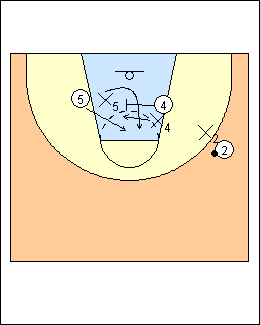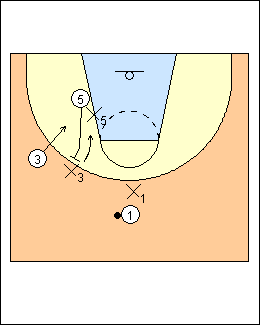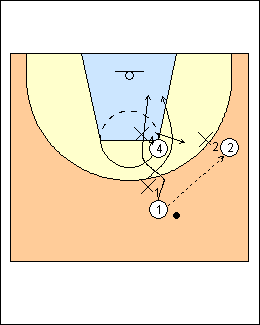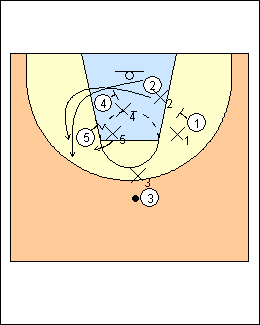Defence
Defending off-ball screens

| 1 Screen situations: Options for the defender of a cutter using a screen (xcutter) are to switch, go ballside (slip inside), go outside (manside, take away a fade), force the cutter inside or outside and chase, or just chase him whichever way he goes. One approach is that the defender of the screener (xscreener) leaves room and xcutter goes ballside, or optionally goes manside and chases the cutter (see Roy Williams, Jamie Dixon). The xscreener helps, e.g., shows in a passing lane or bumps a curl cut, but still guards the screener. Automatic switching is effective late in the shot clock, and also involves going ballside. Herb Brown - defending a player who wants to use a screen, never let him get to your body, move to keep distance, learn to slip screens and avoid being picked off, a moving defender is hard to screen. Try to force the cutter away from the screener, force him one way and not allow him a choice. The defender of the screener tries to stand up the screener, not letting him screen where he wants to. Jerry Krause - avoid screens whenever possible, be in motion when an attacker approaches to set a screen. Morgan Wootten - xscreener must let xcutter know the screen is coming and back off his man, giving his teammate room to slide through the screen and stay with the cutter. Avoid switching whenever possible. Bill Self - go ballside, it's a cop-out when guys want to piggy-back or trail screens because they're not jumping to the ball. Basketball Canada - basic techniques for defending a screen away from the ball are switching and fighting over or through. The xcutter must fight to the ballside of a screen to follow the cutter or stop a pass to the screener. Players must learn to switch as fighting over or through is not always possible. Hubie Brown - we never follow except on staggers, shoot the gap and make them prove they know how to bump and can hit a shot off it. |

| Downscreen
a) Ballside
Morgan Wootten - as 2 downscreens, xscreener X2 steps off his man toward the ball, giving xcutter X4 room to slide through the screen.
Jamie Dixon - xscreener leaves room for xcutter to go ballside, he will go ballside on a non-shooter, or trail a shooter and xscreener extends the screen, hand in the passing lane, seeing the ball, arm's-length from his man.
Dave Smart - X2 stays in a deny position, one hand on 2's hip, if X4 calls 'gap', X2 takes his hand off and makes room to go through, or if X4 follows O4 around the screen, X2 will jump out to hedge the cutter. Get attackers to go where they don't want to go, force the cutter to make the wrong read, e.g., on a big-to-little downscreen, force the little cutter to curl (chase him out), the big has to vacate. The cutter will probably cut to the wing but that is easy to defend even without switching. Usually gap on a non-shooter (e.g., a big), forcing a flare. Switching is a solid way to defend.
coachesclipboard.ca - defend a downscreen when the cutter is one pass away from the ball by switching, tailing a cutter who is a good shooter, or going ballside when the cutter is a poor shooter. To go ballside, xscreener moves away from the screener in a denial stance, creating space for xcutter to slide through. The xcutter should be a moving target, hard to screen.
Bob Huggins - don't chase, the cutter will curl, gap instead (third man through), then chase over or under the screen if the cutter fades. Ian MacKinnon - X2 leaves a gap, X4 goes ballside or can chase. |

| 3 Downscreen
b) Manside
coachesclipboard.ca - tail a cutter who is a good shooter. As the cutter gets to the screen, xscreener must be out high, chest to the sideline, forcing the cutter to go high, then step back to let xcutter through.
Quin Snyder - X4 follows his man around screens (get on the outside hip if he gets hung up), X2 hedges/shows to buy time for his teammate. Ball pressure is very important because cutters will be open.
Herb Brown - they prefer to lock and trail if the ball is in the middle of the court, getting to the outside shoulder of the cutter.
Ken Shields - xcutter must trail out or go over a ballside downscreen. On a trailout, get to the cutter's baseline shoulder so as not to contact the screen, xscreener bumps any curling action. If the screen is set low, xscreener loosens and helps xcutter over the screen.
Scott Clark - xcutter goes manside unless the screen is distorted (wide or low), then short cut it. The xscreener is help, show with high hands and vision.
|

| 4 Downscreen
c) Switch
coachesclipboard.ca - switching is very effective, particularly when there is not a distinct size advantage or the offensive team does not post up much. It is an aggressive tactic that, if done well, will disrupt the timing and flow of the offence, and is often used at elite levels in the last 5-7 seconds of the shot clock. The two defenders come together to prevent a slip by the screener (talk it, touch it, switch it). The xscreener tries to deny a pass to the cutter then extends the cutter further out.
Dave Smart - switching is a solid way to defend a downscreen, but a big-to-little screen can still cause mismatches. It looks to the attackers like a flare (gapping) situation and they play it that way, the screener adjusts the screen, the cutter flares to the corner than triangles high when the defending post comes out on him.
Basketball Canada - switching on all screens is very effective, but mismatches can occur, e.g., when a post player downscreens for a guard. The xcutter goes above the screen to get ballside, cover the screener, and stop the roll to the basket, but xcutter must stay with his man if the cutter flares to the corner instead of using the screen.
Ken Shields - switching rules are a) equals (same size may switch), b) big-in, little-out (especially weakside), and c) emergency (to cover an open man).
coachesclipboard.net - chase around a downscreen, switching makes you vulnerable to the flare cut to the short corner.
Option - switch back if the cutter fades to the corner.
|

| 5 Downscreen d) Weakside A coaching option is to go through on weakside screens, and around (follow) on the ballside. In some cases (e.g., two passes from the ball), the screen defender can hug a weakside screen, and the cutter defender shoots the gap looking for a steal. Dick Bennett - xcutter chases on screens, but can go ballside from the weakside. If you are being screened, you have no responsibility for help or vision, take care of business, chase him down. The xscreener helps in any way he can but within touching distance of his man. Roy Williams - when 4 passes to 1 and screens for 3, X4 retreats in the direction of the pass then opens up when he sees 4 go away. X3 was denying 3, on the pass he sprints to the lane then reads the screen and takes the best path. If it's a good screen and 3 uses it well, X3 will go one man removed (shown), then has to bust his tail if 3 flares. If 3 doesn't use the screen well and leaves a lot of space, X3 will just go with him. Williams used to say always go one man removed, but then the other team would hit and flare, now he doesn't tell them which path to go.
Herb Brown - if the screen is weakside, xscreener steps back to let xcutter through (he slips the screen inside). They sometimes allow xcutter to go in front of the screener and xscreener. Many times they will play topside of the cutter to force him baseline to the other side of the floor (see wide pin-down below). If the screener screens his own man, xcutter will try to shoot the gap inside since there is no help from xscreener, forcing the cutter to fade.
Morgan Wootten - X3 is coming up the lane and can see the entire court, he should be telling X4 what to do. X3 moves into the passing lane to deny the ball because he is now one pass away, X4 is now two passes away and should take a step off his man toward the ball to take care of weakside defence. A defender should never be more than one pass from the player he is guarding.
Ken Shields - xscreener loosens and helps xcutter over the screen. |

| Screen away
The xcutter goes through or over the screen, switching is a coaching option. It is hard to screen X3 because he is moving to a help position on the pass.
Here if X3 goes over the screen, X1 hedges or bumps the cut. X3 tries to stay with 3, maintaining a ball-you-check position, or instead tucks and trails by directly following (caboosing) the cutter around the screen. X3 doesn't give 3 the option to fade the screen.
Herb Brown - on a horizontal pass and screen away, xscreener steps back and lets xcutter slide through the screen, or xcutter bodies up and rides the cutter over the screen, or the two defenders come together and switch.
Basketball Canada - fighting over screens helps avoid mismatches and encourages aggressive play on defence. It is similar to fighting over a ballscreen. The xscreener hedges to make the cutter go wide, and stops a pass to the screener. It may be necessary to switch if the cutter fakes high and goes low.
coachesclipboard.net - to switch, X3 drops back a step or two just before the screen arrives to avoid getting sealed (step under and switch).
|

| Zipper (vertical) screen
Herb Brown - xscreener stands up the screener and stays attached allowing xcutter to go in front of the screen, stopping the cutter from getting a pass or causing him to get it further out on the floor. The xcutter slips the screen inside by moving toward the ball, which draws him in its direction.
Your mind-set should be to never let yourself be screened, slip inside the screener if possible.
|

| Wide pin-down
goxavier.com - top lock on the cutter if he is a great shooter. As 4 screens for 2, X4 drops closer to the baseline in a great help position, X2 positions himself in a top-lock position while defending 2, forcing him to reject the screen and cut backdoor. On a pass to 4, X4 closes back out.
Herb Brown - xcutter plays on the top and outside the cutter to force him baseline away from the screen, pressure on the passer helps xscreener. Or X4 stands up the screener then steps back to let xcutter go through, causing the cutter to fade.
|

| Cross-screen
Dick Bennett (shown) - xscreener follows the dangerous cut and covers the basket with his back to the baseline, the xcutter makes a v-move above the screen then back down.
Morgan Wootten - xcutter takes one step up the lane towards the ball to take away the high cut, xscreener defends a low cut. If the cutter comes high, xcutter denies a pass. If the cutter goes low, xscreener delays the cut allowing xcutter to get around the screen, but xcutter must insure that the screener does not flash back to the ball.
Bill Self - a) xscreener stays with his back to the basket as the screener goes away, xcutter meets the screen with his forearm to create space, then whichever direction the cutter decides to go, rides him out with his other forearm, xscreener is high and loose if the screener ducks in, or b) xcutter goes ballside, see Bill Self 4 in the lane.
Dave Smart - call "cross", xdribbler attacks the ball knowing that the attacking post players will be moving to the ball-side block and elbow, taking away space for the ball handler to drive the basket. Ian MacKinnon - X4 hedges the cutter low with his butt to the baseline, X5 goes over the screen (seeing the ball) then recovers if 5 goes under the screen, X5 can't let 5 flash high for a pass. Defending a flex screen is the same, X5 wants to go ballside over the screen (unless the screen is high on the lane line, then go under), so he jumps to the ball and sits on top of the screen, seeing the ball, X4 hedges low.
|

| 10 Cross-screen (continued)
Herb Brown - xcutter bodies up to the cutter and forces him to go from low to high (uphill), away from the low block, but normally switch big to big. However, many teams have xscreener bump the cutter and xcutter goes under the screen, while others have xcutter ride the cutter low toward the baseline (defend a baseline flex cut this way, or switch a big-to-big flex screen).
Jamie Dixon (shown) - xcutter goes under the screen, xscreener is beside the screen and stands up the cutter if he goes over the top, xcutter meets the cutter ballside.
Bob Huggins - xscreener jams the cutter if he comes high, helping xcutter, who leads the cutter to the ball; if the cutter goes low, xcutter snaps his head, also goes under the screen, and ends up high side.
Hoop Tactics - xcutter forces the cutter to the baseline then steps over the screen, xscreener steps toward the baseline side of the screen. Switch if the cutter goes low, don't switch if he goes over the top.
Ken Shields - xcutter stays with the cutter if he goes low to prevent layups; may switch and deny if he goes high.
Scott Clark - xcutter pushes the cutter high then goes under the screen, xscreener bumps the cutter back to xcutter.
coachesclipboard.net - it is best to switch inside post screens, usually you do not end up with a mismatch, but on a lateral post screen, xcutter steps under the screen toward the baseline and stays with his man if the cutter goes low, or switches if the cutter goes high, xcutter is in a good position to step around and 1/2 front the screener from the baseline side.
Greenvale Grizzlies - if the cutter goes low, xcutter must fight low and chest him as they cut to the ball; switch if the cutter goes over the top.
goxavier.com - xscreener drives the screener low and xcutter rides the cutter high, preventing the screening action, and moving the cutter above his desired post-up position.
Bob Hurley - switch only on lateral cross- screens, a good way into the season you may want to begin switching other stuff, but make sure you get your guys playing the way you want before offering them the switch bail-out.
|

| Backscreen
Some coaches emphasize that X3 must get ballside position, some allow X3 to fight over or under the screen. Other coaches will switch on backscreens, especially big-to-small screens, since it keeps post defenders near the basket, or when the cutter goes baseline.
Herb Brown - when defending a player setting a back pick don't chase him (don't screen a teammate by playing too close to the screener), be in position to bump, step out and hold up the cutter. The xcutter bodies up and rides the cutter over the screen away from the basket, or slips inside the screen and xscreener bumps the cutter.
Bob Huggins - on a backscreen, snap your head, find and meet the screen (arm out, hand into his chest), then step through inside.
Dave Smart - xcutter can jam the cutter, force a basket cut or backdoor cut and chase, but most teams force a flare or switch on a backscreen. To switch or force the flare, the xcutter jumps to the ball. On a switch, defenders come together to prevent a slip by the screener.
coachesclipboard.ca
1) Ride the cutter off the screen - if the cutter is a good shooter, xcutter gets into his top shoulder and doesn't let go ballside. Xscreener protects the basket, stays away from the screen so he can help if xcutter gets caught, but is ready to close out quickly if the screener steps out and can shoot.
2) Go ballside (shown) - the cutter is a poor shooter, xcutter jumps to the ball, gets into a denial position above the screen, and can then go either side of the screen to recover to the cutter. Xscreener protects the basket, especially if the cutter fades the screen for a pass and drives the basket.
3) Switch - best strategy when the cutter and screener are similar size, the safest because it protects the basket. Very effective late in the shot clock, and can keep bigger defenders near the basket. To prevent a slip by the screener, xcutter jumps to the ball to get inside position on the screener, and xscreener must wait before switching out. Ian MacKinnon - X5 triangles ballside and leaves a gap for X3, who goes ballside of the screen. If 5 re-adjusts the screen and 3 bumps and fades, X3 wants to go over the re-screen if he is forcing baseline, or under the screen if forcing middle.
|

| 12 Backscreen (continued)
Dick Bennett - xcutter chases, but can go ballside from the weakside, xscreener helps in the direction the cutter is going, they won't hit the screener as quickly as you think.
Jamie Dixon - xcutter goes under the backscreen, xscreener stands up a cutter going over the top, or if X3 can crowd 3 and go the same route, that's the best way.
Scott Clark - xscreener zones and sees xcutter through (step low of screen), xcutter goes to the body and chases unless the screen angle is distorted, then short cut it.
Jack Bennett - xscreener must step out and help (show) then recover to his man (early help, early recovery), he can't let a single screen become a double screen by getting in the way. If you switch much, it takes away your match-ups.
Ken Shields - xcutter must fight over or under the screen, xscreener must see his partner through the screen then recover to his man.
Basketball Canada - backscreens may be difficult to execute if defenders jump to the ball on passes. Switching is recommended, although players may wish to fight over the screen and switch only if the cutter goes baseline.
coachesclipboard.net - switch backscreens, it can create a mismatch but at least both attackers are guarded, switch back at the earliest opportunity. The xcutter aggressively steps over and around the screen (ballside).
|

| Flarescreen
coachesclipboard.ca
1) If 1 is a shooter, go over the screen, force him to the basket. X3 sags off 3 to protect the basket in case 1 goes to the hoop, but can't sag too far in case 3 slips. X1 gets into the body of 1 and rides him off the screen, or trails 1 over top and regains position on the other side.
2) If 1 is a poor shooter, go under the flare screen (shown). X3 jumps to the ball to give space for X1 to slide underneath the screen. X3 does not have to sag because 1 will not be able to get to the basket, but jumps far enough to prevent 3 from slipping directly to the basket. X1 moves below the screen and recovers to the cutter with a good close-out.
3) If 1 and 3 are similar size, switch. X1 gets level with and inside the screener to prevent a slip, X3 also prevents the slip by getting directly below the screener, but then quickly recovers out to 1 when X1 is in position.
|

| 14 Flarescreen (continued)
Alvin Gentry - xcutter chases the cutter over the screen, xscreener zones up towards the ball to prevent a curl cut or a slip to the basket by the screener
Herb Brown - xcutter bodies up to the cutter and fights over the screen; xscreener tries to help by screening the screener or by faking at the cutter to hold him up, but must also be aware of the screener trying to slip to the basket.
Basketball Highway - xcutter must ride over the top of the back pick, xscreener helps and hedges the shooter long enough for xcutter to recover; if xcutter gets completely hung up, xscreener must switch, and xcutter must seal the screener rolling to the basket.
Scott Clark - treat it just like a backscreen, chase unless distorted.
|

| UCLA screen
Bob Huggins - the xcutter defends a UCLA cut by going between the screener and xscreener (shown)
See FIBA 3 on 3 backscreens in Defending - on a backscreen towards the ball, xcutter goes ballside between the screener and xscreener.
Jamie Dixon - xcutter goes laneside, xscreener stands up the cutter ballside, right beside the screen.
Basketball Highway - xcutter stays in front of the cutter, xscreener may bump the cutter then recover, optionally the defenders switch if the cutter goes behind the high post screen.
Larry Brown - xscreener stays attached to a UCLA screen (plays behind the screener), makes it small, not bumping his own man.
Hoop Tactics - if the cutter goes behind the high post screen, the defenders switch; when the cutter goes in front of the high post screen, the defenders do not switch.
Herb Brown - xcutter bodies up and rides the cutter over the screen if he is a low-post threat, or takes a short-cut below the screen to take away a single or double weakside screen.
Detroit Pistons - xscreener contact shows. Ian MacKinnon - X1 jumps to the ball and goes ballside, X4 gaps (triangles) ballside. If 1 cuts to the basket off the backside of the screen instead of flaring, X1 recovers through the gap. If X4 squeezes the screen, it puts him in good position to hedge on a ballscreen by 5.
|

| Staggered screen
The xcutter X2 tucks and trails (tail on a dog), the screen defender furthest from the ball (X4) protects the basket from any slip cut, and closest screen defender X5 protects a quick pass, bumping the cut and permitting X2 to catch up. An option is to trap on the catch with X5, especially if 2 is a great shooter. The defender of a cutter who can use either a single or double screen must force the cutter in one direction, then trail.
Jamie Dixon - xcutter forces the cutter to use the single screen, then trails on a shooter, X1 extends the screen.
Scott Clark - chase all double screens, extend the last and zone the first. Ian MacKinnon - chase then bump (switch) the last screen. Variations - X2 trails the first screen, goes under the second or switches on it (Herb Brown) - switch up the line, so X2 takes 4, X4 takes 5 and X5 takes 2 - if xcutter has established helpside position, he goes ballside of the first screen, tails the second (coachesclipboard.ca) - X2 goes ballside of both screens if he wants the cutter to fade.  |
|
















